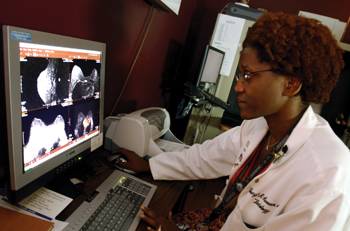
Cheryl Herman, M.D., studies breast MRI scans in the Vanderbilt Breast Imaging Center.
photo by Dana Johnson
Breast Center offers options to high-risk cancer patients
Women in the Middle Tennessee area who are at high risk of developing breast cancer now have access to the latest technology and a dedicated clinic to meet their special needs through the Vanderbilt Breast Center.
Radiologists at Vanderbilt University Medical Center were the first in the region to use Magnetic Resonance Imaging (MRI) for breast cancer screening and diagnosis for women at high risk of the disease. Vanderbilt's MRI facility offers the most powerful MRI technology available for breast imaging in the region.
The center also has developed the area's only dedicated clinic for surveillance, prevention and counseling for women at high risk of the disease because of genetics, family history or personal history.
MRI technology is superior to mammography for detecting breast cancer among this special group of women, and combining the two is even better, researchers reported earlier this year in the British medical journal Lancet and at the 2005 annual meeting of the American Society of Clinical Oncology. These most recent findings further validate two smaller studies published last year.
“Evidence is growing that MRI can be particularly useful for screening women at high risk of developing breast cancer — especially younger women whose denser breast tissue makes mammography more difficult to evaluate,” said Mark Kelley, M.D., professor and chief of Surgical Oncology at the Vanderbilt-Ingram Cancer Center.
MRI, which uses a large magnet connected to a computer to produce detailed images without radiation, is also used to evaluate the extent of disease in women diagnosed with breast cancer and to evaluate leaking from breast implants.
The American Cancer Society and other organizations recommend adding MRI to mammography for regular screening of women at high risk of breast cancer.
That's because some types of lesions, such as tiny specks of calcium or ductal carcinoma in situ (a precursor to invasive cancer), are better detected by mammogram.
However, MRI is not recommended for screening the general population.
“Mammography remains the gold standard for screening women at average risk of breast cancer,” said Cheryl Herman, M.D., assistant professor of Radiology and Radiological Sciences and co-director of Breast Imaging at the Vanderbilt Breast Center.
During an MRI of the breast, the woman lies on her stomach on a cushioned scanning table. The breast lies in a depression or hollow in the table, which contains coils that detect the magnetic signal. The table is then moved into a hollow tube that contains the magnet.
A series of initial images are taken, followed by administration of a non-radioactive contrast dye, and additional images are taken. At Vanderbilt, the radiologist watches carefully as the dye is distributed through the breast and then eliminated. “The pattern of how the dye flows in and out adds information for a diagnosis, because that pattern tends to differ between malignant and benign lesions,” Herman said.
Because MRI can detect lesions that are only visible with that imaging technology, it is important for patients who undergo MRI for breast screening to do so at a center — like Vanderbilt — that also has the ability to do biopsies under MRI-guidance, experts say.
MRI does have its drawbacks. Not all of the tiny lesions it detects turn out to be malignant (so-called “false positives”). That can result in more biopsies or other procedures.
“MRI has a higher sensitivity than mammography but its specificity is lower,” Kelley said. “There is no question we can see many things on MRI that are not seen with mammography. Some of these findings are malignant, but many of them are not. Skilled and experienced radiologists and the proper equipment are needed to accurately analyze those images and determine which findings are suspicious enough to warrant a biopsy.”
An additional drawback is length of the procedure (about an hour, about four times longer than a mammogram) and cost ($1,000 or higher, about 10 times the cost of a mammogram). Some insurance plans cover breast MRI for screening high-risk women, but many plans do not, Kelley said.
“For women at high risk of developing breast cancer, however, the benefits of catching cancer earlier may offset the drawbacks of adding MRI to their screening routine,” Herman said.
Breast cancer is the most common malignancy in women, affecting more than 217,000 women in the United States each year and 4,300 in Tennessee.
For women of average risk, the American Cancer Society recommends that women in their 20s and 30s have a breast exam by a health professional at their annual physical exam and talk to their doctor about self-breast exam. At age 40, Cancer Society guidelines call for adding mammography annually starting at age 40.
Women at high risk for breast cancer because of genetic abnormalities like BRCA1 or BRCA2 mutations, family history or other factors often are encouraged to begin screening earlier.
The Vanderbilt Breast Center now offers the region's only dedicated clinic for these women, including comprehensive consultation with the Vanderbilt-Ingram Cancer Center's Family Cancer Risk Service and focused management by radiologists, surgeons and nurses.
“Women at high risk for breast cancer require special surveillance and management,” said Ingrid Meszoely, M.D., assistant professor of Surgical Oncology and medical director of the Vanderbilt Breast Center.
“Evaluating their risks and options is complicated. It is important for women to have access to comprehensive consultation and counseling about genetic testing and screening or management options and to a health care team with experience in treating high-risk patients.”













